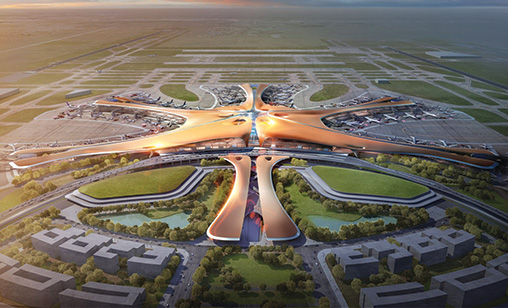China
All eyes on Beijing Daxing
June 1st 2019
Drones provided photographic updates about the steel and concrete infrastructure rising south of Beijing. Read More » Now they are prohibited from flying over the site. The International Air Transport Association has assigned the identifying code PKX. Finally, an armada of wide bodies have flown in to test the facility.
Beijing Daxing is transitioning from construction project to airport.
The opening of Beijing’s second major airport is near with a service commencement on or before September 30. That ends a construction programme that is immense but small compared with decisions about how multi-airline competition should develop in Beijing. This will be a blueprint for other cities and will slowly wind back China’s “one airline, one route” policy.
 |
The CAAC has given preliminary approval for 10 international routes from Beijing Daxing, but these are flying to the relatively uncontested markets of Cairo, Russia and cities in South Korea, but not Seoul. The flights are China Eastern’s Busan, Cheongju, Gwangju and Daegu; Xiamen Airlines to Busan and HNA’s Beijing Capital Airlines to Busan, Xian-Cairo, Cairo non-stop, Moscow and St Petersburg.
The more significant international flying programme will be to blue chip cities. This will see Air China lose its Beijing stronghold because China Eastern Airlines (CEA) and China Southern Airlines (CSA) have base rights at Beijing Daxing. Memories are still fresh of the contested Beijing-Paris route that CSA wanted to service with the A380.
It is unclear how quickly competition will be allowed. On paper, there are stringent rules. A Civil Aviation Administration of China (CAAC) regulation says a long-haul route can have another competitor if the existing Chinese airline has less than a 70% frequency share and a total frequency from Chinese and foreign airlines up to 14 weekly flights.
If the 70% threshold requirement is not met, competition can be introduced if the existing airline has held a monopoly for six years. But proclamation and implementation can be different.
Also to be seen is what Air China (AC) receives in exchange. Reciprocal access in Guangzhou and Shanghai, the hubs of competitors, is made easy with Shanghai Pudong’s terminal expansion and Guangzhou’s recent terminal expansion that opens room for other carriers.
The one airline, one route policy had a goal to limit over-competition and make Chinese airlines compete against foreign airlines.
Now they will have to compete with themselves, taking their strong domestic competition to international flights. They have had indirect exposure via connecting flights, but local traffic and nearby connections usually dominate their schedules.
Consider the Los Angeles-Shanghai route. All three major U.S. airlines fly between the cities, but there is only one Chinese airline, CEA, which has double daily flights. The U.S. has a market share advantage because Chinese gains are dependent on only CEA growing.
Simultaneously, CSA is contending with the globally unprecedented action of being a major airline exiting its global alliance, SkyTeam. Airlines have left an alliance for another and Aer Lingus departed oneworld to go independent, but there is no comparable action to the exit of CSA, Asia’s largest airline, from SkyTeam.
So far CSA has been able to maintain most of the benefits of SkyTeam, but it is to be seen how bilateral relationships evolve with time and as SkyTeam members become cosier with each other through new or stronger joint ventures. There is an unmistakable AFI KLM-Delta Air Lines -CEA axis.
CSA has added to its partnerships with an expanded deal with oneworld’s American Airlines (AA). AA lacks a mainland Chinese partner. The two have flagged more is to come. CSA also has cosied up to oneworld’s British Airways and Finnair, raising the question that it could join oneworld. Cathay Pacific sees itself as the alliance’s gateway to mainland China.
CSA’s AA partnership is notable as Chinese airlines often are most optimistic about North America for their long-haul markets. The partnership prize is a joint venture, but the U.S. would require open skies as a prerequisite to such a deal. Traffic right discussions have been supplanted by contentions about slot access. Open skies is ineffective without reasonable access. Beijing Daxing’s opening and Shanghai Pudong’s expansion generate the slots needed for open skies.
China-U.S. open skies would impact regional markets, such as China-Korea open skies, and airlines needing to stitch together their various joint ventures in Asia. This will need time. But Daxing is racing ahead. The CAAC expects to have 72 million passengers a year passing through the airport by 2025.